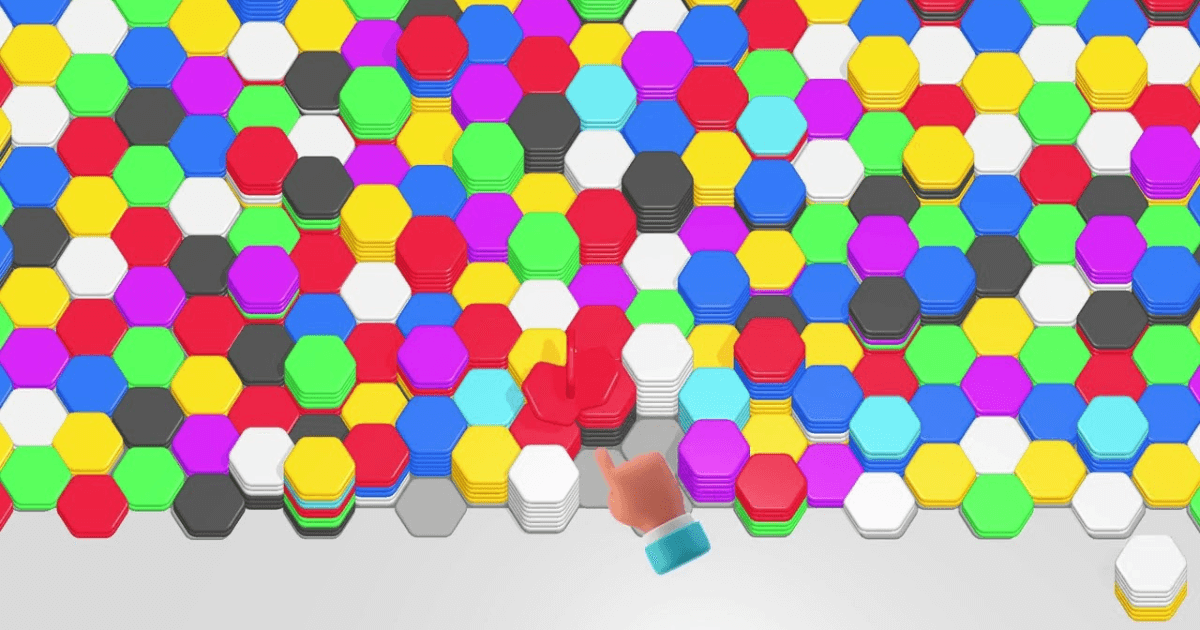Have you noticed how players in mobile game ads fail at extremely simple tasks?
This is no coincidence.
“Fail ads” are a tried and tested strategy used by experienced game marketers. To help you understand it better, we’ll go over all the ins and outs of using this advertising technique, including:
- How fail ads work
- How they can lead to lower CPIs
- Their main advantages
- Why they are controversial
- How they are used by top mobile games (examples)
What Are Fail Ads
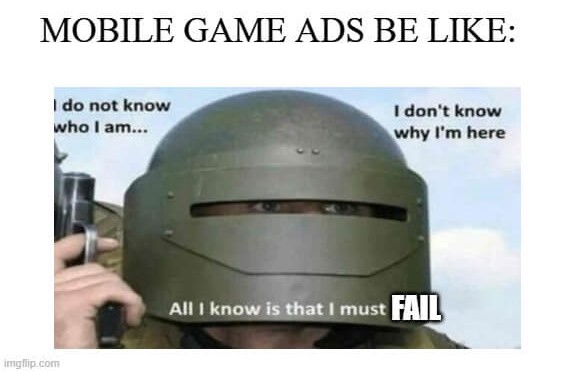
Just like their name suggests, fail ads are ad creatives that feature losing scenarios. In these ads, a “player” who engages with the game, but their attempts are unsuccessful.
But it’s not just about losing.
It’s more about HOW they lose.
The thing is, the gameplay shown in these ads usually seems utterly simple. For example, fail ads often feature a player choosing between two options, constantly going for the wrong one. Or they show them playing the game in a completely illogical way.
Seeing this, viewers can’t help but wonder: “How can someone fail at something so simple?“
With this in mind, viewers might get a strong desire to download the game and try it out for themselves.
Common Features
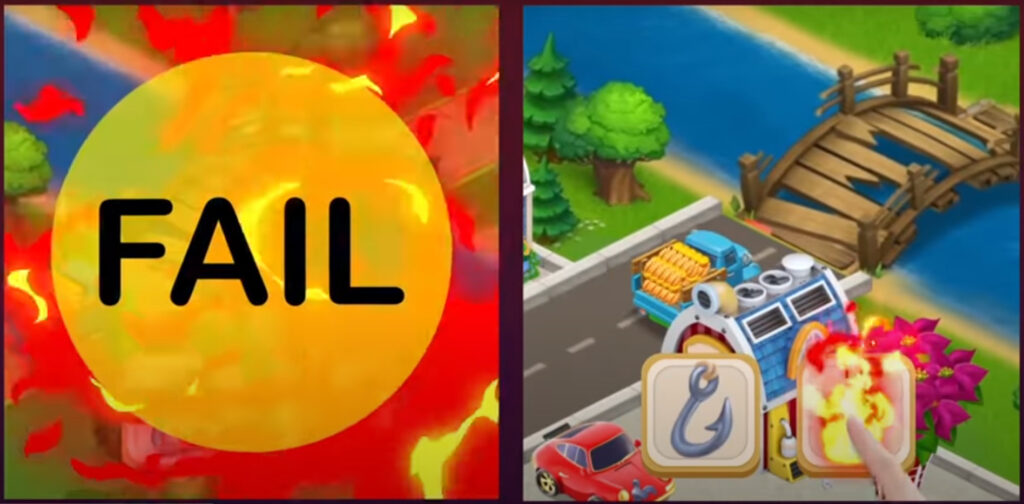
Fail ads are easy to spot because they have some common features that stand out.
Typically, the fail scene happens early in the ad – within 5 to 10 seconds. To emphasize this moment, it is often followed by different visual and sound effects. For example, a “fail” sign, red effects, negative emojis, buzzing, and blooper sounds.
Moreover, if the ad features characters, you can expect to see them in negative emotional states such as crying, anger, and disbelief.
The “Player”
Fail ads display the person playing the game in different ways.
In many fail ads, the player appears in the form of an animated hand, while others use losing gameplay without any human elements.
Generally, this depends on the gameplay mechanics used in the ad. For example, it makes perfect sense to use an animated hand in a game that requires tapping. But when it comes to games with, for example, swerve mechanics, this makes hardly any sense.
Alternatively, some fail ads feature actual footage of a person playing the game, expressing different emotions along the way. This approach is often seen in collaborations between games and influencers, adding a relatable touch to the ad experience.
5 Reasons Game Advertisers Use Fail Ads
There are many reasons why ads with fail scenarios tend to perform better than ads with winning gameplay.
Ultimately, it comes down to one thing – the psychological effect.
Considering this, let’s delve into the top five reasons why fail ads are such a popular choice among game marketers.
1. Driving Emotion
The main purpose of fail ads is to trigger an emotional response from viewers. Unlike ads with winning gameplay that are meant to cause positive emotions, fail ads are designed to frustrate people.
Frustration is a strong emotion, and when it strikes, people usually become determined to prove their point.
In this case, viewers can deal with their frustration by downloading the game and outperforming the “person” in the ad.
2. Teaching the Rules
In fail ads, viewers can see an example of what NOT to do in the game.
This automatically makes the viewer familiar with the game’s rules, educating them before they even reach the tutorial.
Of course, this is only true if the fail ad contains actual gameplay, not a fake one. While fake ads can successfully drive frustration and draw attention, they are ineffective at teaching players the game’s rules upfront.
3. Creating a Sense of Difficulty
With the help of fail ads, game marketers can trick people into thinking a game is either super easy or super challenging.
Let’s say they want to produce two completely different ads for the same puzzle game.
Scenario 1. A player can’t seem to solve an extremely simple puzzle where the solution is obvious to anyone. This way, the game sets a low bar so people are not intimidated to download and play it.
Scenario 2. A player is struggling to solve a complex puzzle. This makes the viewers install the game and try out this challenging-looking game.
These two fail ads will attract players with different interests. While the first will most likely attract people looking to relax, the second might appeal to those looking to challenge themselves.
If you want to learn more about different types of players, read our recent article on the top player personas in mobile games.
4. They Can be Captivating
When viewers watch ads with fail scenarios, they frequently stick around until the very end.
Why is that?
They want to find out if the player will ultimately win or lose the game. In a lot of cases, they long for a happy ending.
Here are a few examples of how you can use fail scenarios to keep viewers “glued” to their mobile screens:
- Create ads with a series of fail scenarios and cut off the video the moment the player is about to succeed
- Begin with multiple fail scenarios to display the player’s effort and then end with a win
- Start with a win, then unexpectedly make the player play poorly in the rest of the ad
5. Lowering CPI
Well-made fail ads should capture attention and drive engagement from the target audience.
This should reflect in the games’ advertising metrics, improving their click-through rates and conversion rates. Consequently, well-performing fail ads often result in a lower cost per install (CPI) and overall better campaign performance.
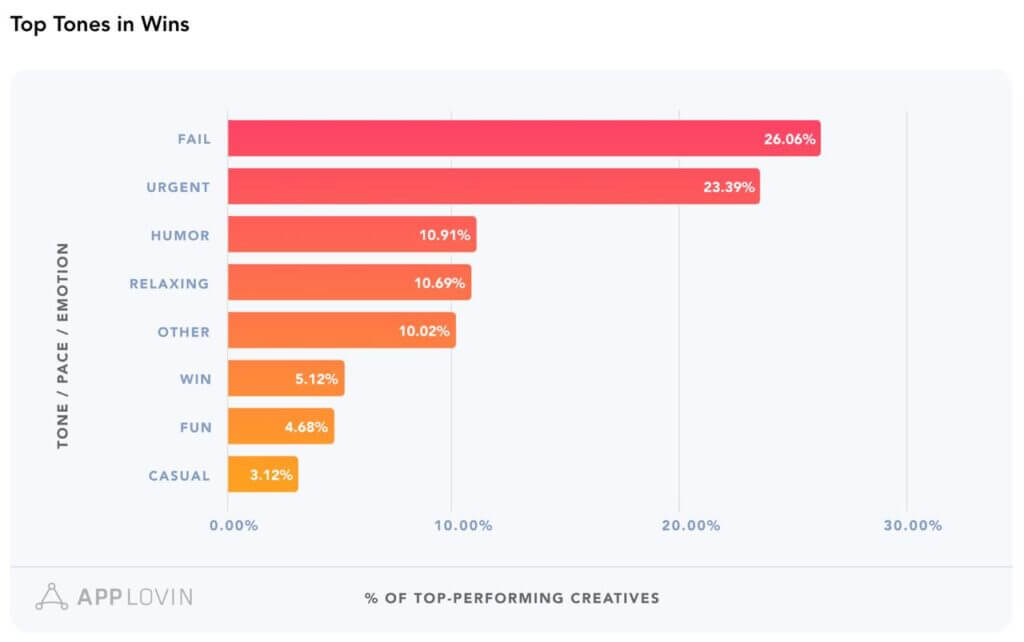
According to AppLovin, ads with the “fail” tone work better than other popular tones like urgency and humor, making up for 26% of top-performing creatives.
Fail Ads for Mobile Games: The Not-so-Good
Fail ads are not exactly the players’ favorite.
At least not on a conscious level.

Even though they are not nearly as hated as fake mobile game ads, there are many players who dislike seeing fail ads. This is usually because they’ve seen too many of them in the past and they can’t get fooled by them anymore.
Fail ads are also common meme material. People tend to make fun of fail ads because they are illogical and obviously deceptive. Or in a lot of cases, completely ridiculous.
Examples of Fail Ads in Mobile Games in Top Games
Game marketers have been using fail ads for years.
This naturally makes you wonder – do they still work to this day?
Judging by recent ads launched by top mobile gaming companies, the answer is a clear yes. If they didn’t work, they wouldn’t be using them over and over again.
Let’s go over some examples of fail ads in top games.
Tall Man Run
This game has been sitting on the hyper-casual top charts for a while now. Looking into its ad portfolio, we found numerous examples of fail ads with similar scenarios.
Here’s an example of one that has been out since April, indicating that it performs well.

The game’s protagonist, Jelly Man, runs on the track and needs to make a choice between numbers that help him grow or decline. He starts with two logical choices, but somewhere around the fifth second of the ad, he begins to make poor choices, before concluding the ad with the worst possible moves, leaving him with nothing but a head.
This ad doesn’t feature any special effects to highlight the fail scenes because the gameplay makes it clear what’s happening, so any effects would be redundant.
Intention: This ad is designed to take viewers on an emotional rollercoaster. Alternating between good and bad moves, the ad keeps people interested in the outcome until the very end.
Mob Control
Voodoo’s Mob Control is currently one of the biggest hits on the games market. This game successfully transitioned from hyper to hybrid casual, which we analyzed in one of our recent articles.
To advertise this game, Voodoo often uses fail scenarios.
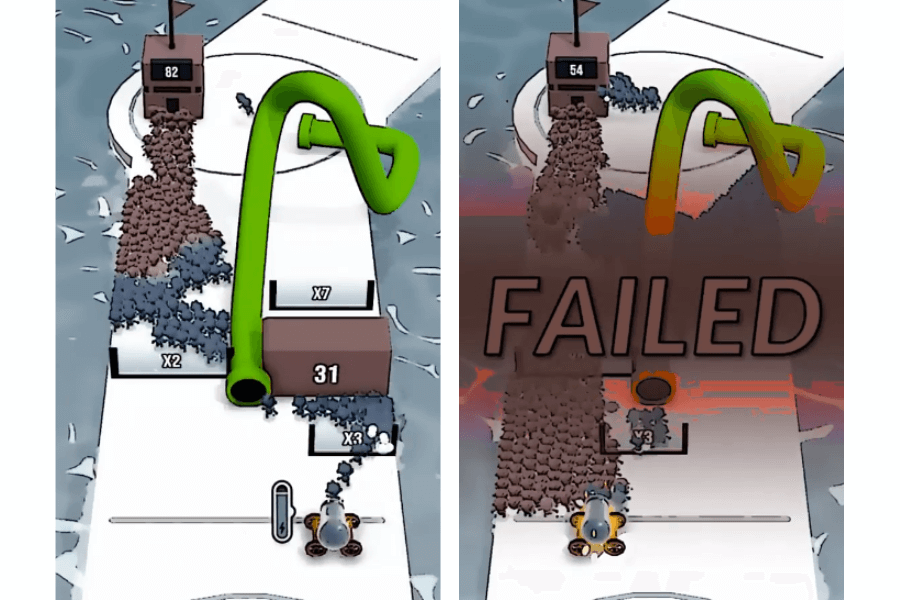
In the example above, the player starts by playing logically, but things soon go south, leading to a fail at 0:15.This is emphasized with red effects and a big “fail” sign. Afterward, the gameplay continues with another attempt that might result in a win, but the ad cuts off before we find out the result.
Intention: The viewer should get frustrated by the player’s poor strategy, while the cut-off winning scene leaves them longing for a happy ending.
Project Makeover
Project Makeover is known for its controversial ads. But, here, we won’t waste words on their fake gameplay and shocking content.
We’re here to focus on the use of fail scenarios in the game’s ads so here’s an example.

In this ad, the player (animated hand) needs to prepare the protagonist for a date. Given multiple options, they make a series of mistakes that leave the character in a desert crying, bold, and with smudged makeup. The player’s irrational choices in this ad are additionally highlighted with X marks, leaving zero room for confusion.
Intention: This fail ad could lead viewers to different thoughts that may drive them to download the game. For example:
- “Why is this player ruining everything? I want to help the character out!”
- “Can you really mess things up like this in the actual game?”
- “This game must contain some interesting decision-making”
Fail Ads Won’t Work for All Games
You already tried all the best practices the top mobile game companies use in fail ads, but they still don’t work for your game?
We’ve had many clients complain about this, struggling to reach a quality audience with traditional video ad networks. But, thanks to our unique ad formats, they’ve managed to reach new high-quality users who love their games.
Interested in learning more? Explore our advertising solutions today!



